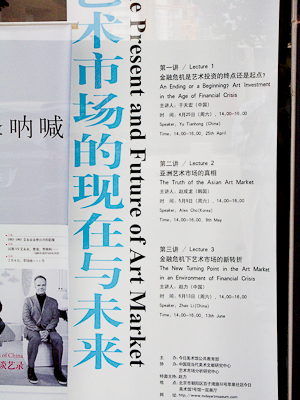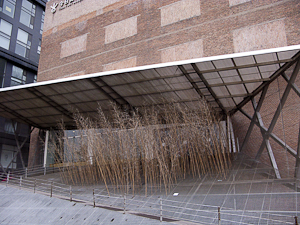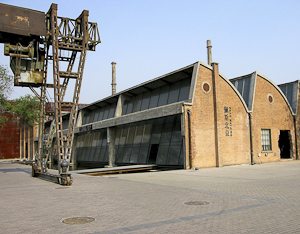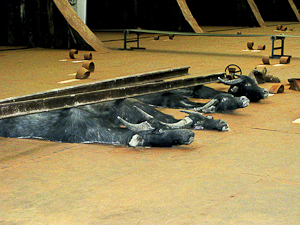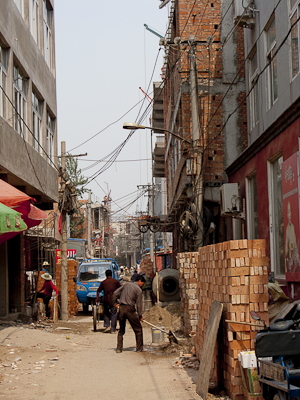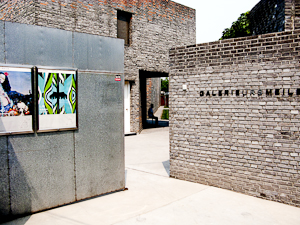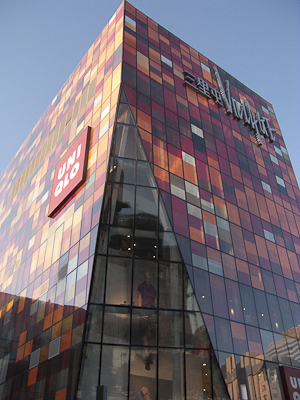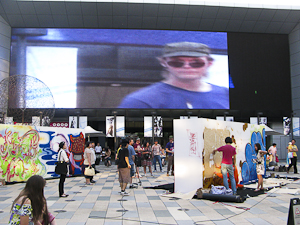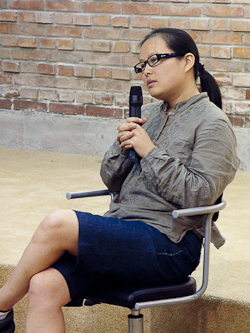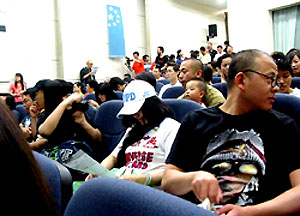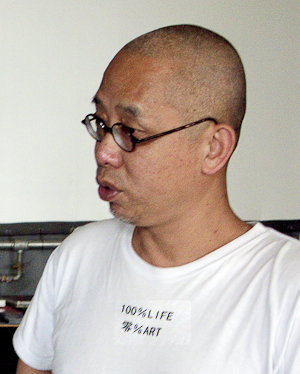|
|
| Travel Notes from Beijing In keeping
with the spirit of its mission, ThePointerAdventure went to Beijing
this summer 2009 to reinforce links with the Chinese art and film
market. We found a buzzing, cosmopolitan city, open to private
entrepreneurship.
Everything
is possible in Beijing, the Asian city that never sleeps. Here
you will find tiny shops where you can buy cigarettes, beer, packs
of dried food, instant noodles, yoghurt, stamps, …in short,
anything you are likely to want in a night filled with insomnia.
The cultural scene is vibrant –though the art market has
suffered from the financial crisis.
The most important collectors of contemporary Chinese art today are not Chinese. For instance, the interest in Chinese contemporary art in Switzerland, which has some of the world’s most important collectors, was initially created by Uli Sigg, a former Swiss ambassador to China. But things are changing in China. The World Bank just raised China 2009’s economic growth forecast to 7.2% and with China’s economy still expanding due to important investments in infrastructure, there will be more and more billionaires in China who are likely to be interested in art in general, and more specifically in Chinese artists.
The sponsorship for this benchmark exhibition comes mainly from Western companies based in China but some Chinese investors also helped.
Art districts are mushrooming in the capital and its vicinity. The most famous one, Dashanzi 798, has been making the cover stories of art magazines since 2002, when art galleries started to occupy an empty former military factory complex. The area still belongs to the military and working factories continue to produce electronic components in buildings that were erected by East German architects in a Bauhaus-style in the late 1950s.
It is a very strange feeling to come out of the Ullens Center for Contemporary Art, an impressive 8,000m2 space, that intends to be China’s most comprehensive not-for-profit organization for contemporary arts, then take a side alley and hear the noise of machines hammering metallic objects and see a worker smoking a cigarette and gazing at us in bewilderment.
As Pan Xing Lei, an artist friend who was leading us through 798 put it: ”These guys will never buy contemporary art. They are completely cut off from the jet-set society that is looking at the best market deal to make their walls pretty while workers have to put food on their own table.” This dichotomy is enhanced by the fact that many fancy cafés, small restaurants and refreshment stalls are taking former gallery spaces, which cannot continue to pay the constantly increasing rent. Interestingly enough, the red umbrellas offered by Coca-Cola that dot the refreshment stands echo the traditional color of China.
Artists in Beijing question whether 798’s future can represent cutting edge art, even though it is the third most visited tourist attraction in the city. Brian Wallace remarked that the trend at 798 is more towards retail art. Many artists
have left their studios and major galleries are moving out to
more remote neighborhoods like Caochangdi, located 5 km North
of 798.
For the moment, famous art galleries such as the prestigious Urs Miele Gallery from Lucerne are operating from compounds that resemble palatial estates. The scene looks quite surreal, with artistic zones completely cut off from each other and coexisting with large business complexes like Staples, a leading American office supply company. Caochangdi does not yet attract huge crowds. “We do not get the drop-in crowd, “ said Fabien Fryns, “the passers-by, the young couple with cameras, but that is not what we are looking for.”
Crowds of young fashionable professionals, families with small children, and students strolled leisurely by on a Saturday afternoon on the main commercial square of the trendy area of Sanlitun to watch and comment on two groups of artists covering two huge wall-like structures with spray paint. “Patchwork,” the name of the event, involved French group TT Crew and Beijing’s BJPZ, who painted 114 canvases in one afternoon. The Village, as this area is called, is home for Apple, Adidas, LeSportsac, Starbucks and Steve Madden.
This year,
the festival showed the latest Chinese documentaries such as “The
Sound of Silence”(2008), a film by Wang Yang recording the
journey of several young people facing changes in their life over
a period of seven years. The impossibility of finding a decent
job after a college education leads to interrogation about the
disappearance of youth. “Up the Mountain” (2009) by
one of the rare Chinese female filmmakers, Huang Ruxiang, talks
about a Christian family whose members are trying to relate the
rules of a controlling church to the requirements of civil society.
This leads sometimes to disruptive behavior.
enjoy this
last stretch of freedom. Again, policemen arrived at the site
of the accident and try to gather the animals. The scene is worthy
of a Marx Brother film in which trying to catch the unpredictable
makes you an integral part of the unexpected. The documentary,
though dealing with the strangeness of people’s behavior
and a lack of social order, is full of moments of humanity (the
police feeding a lunatic), derision (after having gathered the
pigs that are taken for slaughter, a police man says to the conductor
of the truck that the platform is too small and that there is
no ventilation for the pigs, an inhumane act), and rough drama
(a family finds a baby girl abandoned in a field and does not
know what to do with her.) Finally, the short version of “Petition”
(122 minutes in contrast to the long version of 318 minutes),
by Zhao Liang (2009) drew applause from the audience at several
points during its showing. For 10 years, the director followed
the life of people who, year after year, appeal to the higher
authorities in Beijing for help. Coming from various parts of
the country, this is their last resort for justice and they finally
end up by living around Beijing Southern Railway Station in squalid
conditions. Their story is one of hope and faith in humanity and
in the political and judicial system.
As the filmmaker
Wu Wenguang* told us in Beijing “a documentary is an opportunity
to change yourself, to change your life.” The truths about
one society can provide the greatest insight into who we are.
Beginning in 2005, China went through a rapid economic development
that allowed some loosening of official cultural policies except
in the domain of film production and distribution. Independent
filmmakers did not have a lot of choice. Staying independent meant
coping with no funding but looking at stories about the reality
of life–but is this not the true definition of independent
film? In an interview given to the cultural magazine “Passages”
of Pro Helvetia (No. 49/2009), Wu Wenguang further explains that
the effect of commercialization and consumerism is the isolation
of free-thinking and independent spirits. Independent filmmakers
provide the most powerful expression of the pathos of the myriad
voices in China. |
All material copyright 2009 by 3 dots water


